#when its no longer spoilers ill make a post showing some secrets people might not have noticed
Note
So, you mentioned putting little symbols and messages in your comic. I did spend some time skimming through Little Brother to try and find those symbols you mentioned, and I do think I found some. But, they were so miniscule and subtle that I decided not to waste an ask bringing something to the surface that could possibly have no meaning whatsoever.
I will continue to try and find them, though. I'll even enhance the images just in case you hid them that well. But for now, this is what I got.

So, I decided to bring some things up that are more light-hearted that most of us have probably already noticed yet didn't think much of.

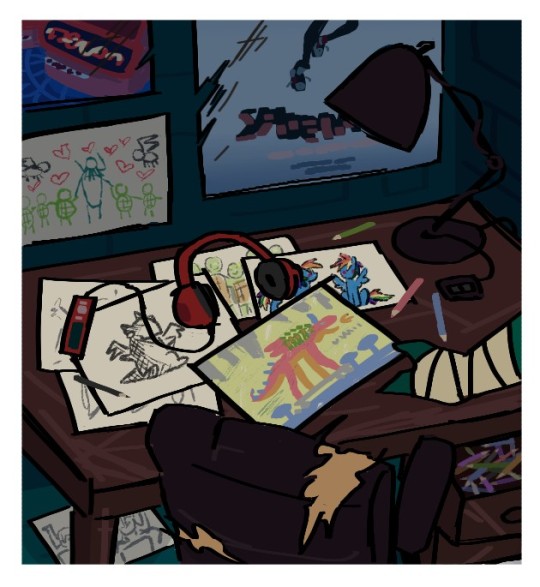
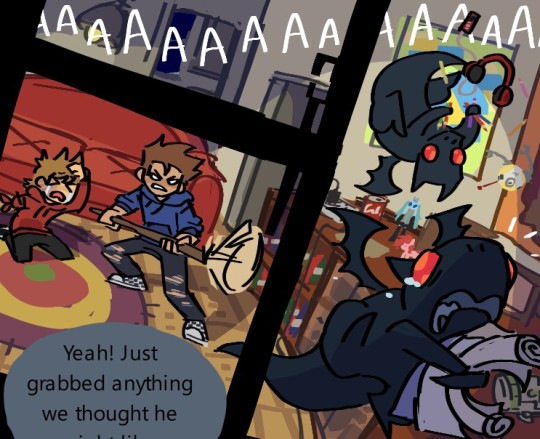


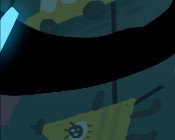

These are just references I've noticed. Or at least things I think are references.
1. The show/shows the turtles were watching after the "three weeks earlier" are some shows I can tell you like. I noticed Danny Phantom, but I don't recognize the one above it.
2. I already made an ask bringing up all the references in Spot's room because it was one of the more obvious ones. MLP, Lemon Demon, and Spiderverse.
3. When Huginn and Muginn explain how they got Spot's stuff for his room, I think the kids in the back are from some other show I don't remember...? I think theirs background characters that you've inserted in that are supposed to be subtle references but maybe that's just me fqfwy2uejejru. I think theirs also little gizmos in the background that are meant to be Easter eggs, but I again can't remember for the life of me, lmao.
4. These are just silly ones since they were edited in for your birthday version of Spot's traumatizing "almost" death. Autism creature, and Finn (ah) from Adventure Time.
5. In the most recent, most traumatizing chapter yet, I saw Bill Cipher from Gravity Falls. I love how he's infested like all of Cartoon Networks shows and now Little Brother, LOL. I think I also see something that's referencing... something? Hehe, I'm really making a fool of myself. You can really tell I have unique tastes in fandoms, huh?
That's pretty much it. If there were any other silly little Easter eggs I missed, then I'll gladly take the criticism. I don't exactly have the best eye for these types of things. Maybe tomorrow or another day, I'll talk about the little details in the comic because there's so many I've seen that made me smile. You put a surprising amount of detail into the background characters, too.
OH YEAH the last ones the portal gun (i really like a lot of valve's games)

#sharkasks#little brother au#when its no longer spoilers ill make a post showing some secrets people might not have noticed#gonna be quite a while before that though.#i am very much expecting this comic to take a lot of time to make
53 notes
·
View notes
Text
Reacting To: Kipo and the Age of Wonderbeasts (Season 2 Episode 5)
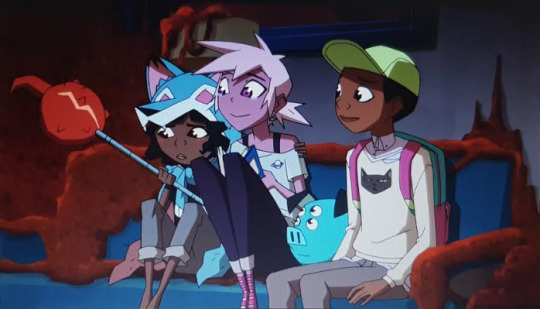
Episode Title: Fun Gus Part 1
Spoiler Warning: Kindly proceed if you’ve already seen the episode or are able to handle spoilers.

1. Just like last episode, this particular one begins with a flashback and this time, it’s Kipo’s parents, Song and Lio Oak whom are climbing up a building with tree roots along its walls. The reach the top and they’re amazed by the view of Las Vistas and the different kinds of mutes living there. Song looks almost exactly like Kipo; Only less...pink.
2. Song has figured out a way to reverse the effects of the mutation in the mutes. And we find out that Hugo aka Scarlemagne was one of the mutes she’s basing her research on! So that explains the supposed backstory between Lio and Scarlemagne we’ve detected in previous episodes.

3. Also, the reason why they’re there in the surface world is to find out more information about the mutes and how to turn them back to normal. However, both Song and Lio don’t agree with their team’s plans and they decide to hide Song’s research findings from them, especially after discovering that Hugo is able to say her name. Now I’m really curious as to why Hugo ended up becoming so anti-human. I guess it’s due to him seeing how humans have been treating animals over the years or something.

4. I just find their interactions to be absolutely precious. They’re also planning to stay on the surface for as long as they can.
5. We’re now back to the present and we see Super Dave carrying his friends over a couple of blocks without molting (I never knew this word till now). They notice that Dave has been able to prolong the very form he’s in, far longer than before.

6. Kipo tells the group that they’re almost at her parents old burrow and she also can’t wait to possibly find out more things about her mom. I’m beginning to wonder if she really died from burrow pox or not? Anyways, Kipo pulls out the map given to her by Cappuccino and it looks like they need to pass through one last checkpoint, a cheese waterfall.

7. They are suddenly interrupted by the water mute Mulholland (from last season), who came through a fire hydrant lol. He’s obviously not welcomed by them, especially after what he did to them before.
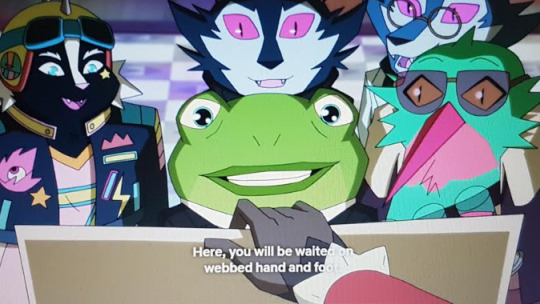
8. At Scarlemagne’s Court, we see the representatives from the 4 pro-Scarlemagne mute groups including the Mod Frogs, Scooter Skunks, Humming Bomber and Newton Wolves entering his residence and being in awe of the place. He wants them to “sing” to him where they think the Mega Monkey might be. Kwat, the Mod Frog sings to him, revealing that it’s in Cactus Town. Because of that, she gets first dibs on a luxury home in the work-in-progress city of Aurum.
9. To my surprise, Scarlemagne reveals that he will be going on the hunt for the Mega Monkey. I gotta say; I do like a pro-active super-villain. We shift things over to the ever-mysterious cloaked individuals who are rushing over to find the Mega Monkey by following an ant trail (because monkeys eats ants?) before Scarlemagne can. But we do find out one of their names: Greta.

10. They spot Scarlemagne and his crew flying through the sky and carrying the mind-control collar for the monkey. So, they need to hurry. I’m starting to think that they’re just humans; I mean look at those eyes.
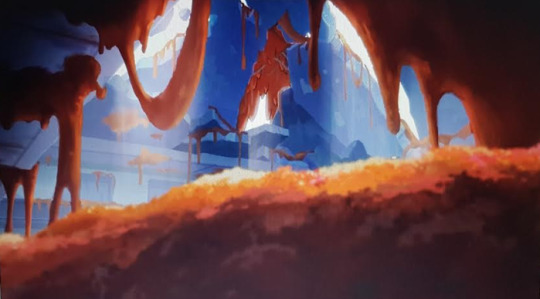
11. Back to Mulholland; He reveals to them that he is now a travelling nomad or nomads and that Kipo is going to find what she’s looking for. He then leaves. That was certainly random. Anyways, they now seem to be near that cheese waterfall place because they finally arrive at the entrance of her parents burrow and there’s cheese everywhere. Correction. FUNGUS everywhere...eww and it moves too. Despite finding the burrow, they still need to find her parents’ apartment.

12. Next, we see the three cloaked individuals riding on a giant dragonfly and tailing behind Scarlemagne and the Nobles. Can the show just tell us who these people are? I’m kinda tired of referring to them as the “cloaked individuals” lol. All of a sudden, a high-pitched sound appears out of nowhere, causing everyone to fall from the sky. It turns out to be the doing of the Umlaut snakes. Looks like these guys are going to take on Scarlemagne but they’re probably not going to beat him I think.

13. Kipo discovers that her parents’ old burrow used to be inhabited by a group of scientists, including her parents of course. They then realize that the apartments are arranged in alphabetical order and they make their way over to the O side to find the Oak’s apartment. Oh and Dave is now in his elderly form after being scared by the fungus creature or whatever. And he is the only one who’s noticing that the orange fungus is moving.
11:59
14. Because humans aren’t as sensitive to sound compared to mutes, Scarlemagne orders his human Nobles to destroy the snakes’ equipment. Scarlemagne orders his followers to attack and the scene cuts off. I’m actually worried about the snakes; I hope they are gonna be alright.
15. The gang is inside the apartment and they’re going through some of their things like their bed, kitchenware and Kipo’s old baby clothes to which she is keeping one of them. Kipo then notices drawings of constellations on their ceiling and points out that the Leo constellation has an extra star, which is actually just a button that opens up a secret panel.

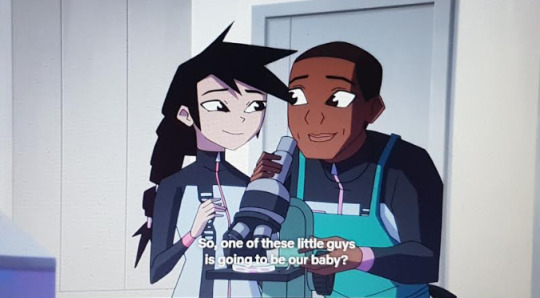
16. The panel reveals a book with the title, “Project Kipo”. She grabs it and starts browsing through it. To sum up what she read, it’s basically about combining Kipo’s DNA with the DNA of apex predators like the jaguar. Other apex predators include the falcon, monkey and Komodo dragon. So this explains in scientific detail why Kipo is their “hybrid-baby”. As a Biochemistry graduate, I find the incorporation of recombinant DNA technology in the story-lines of cartoons to be exciting.
17. Again, I like how Kipo isn’t upset at her parents in any capacity for pretty much making her their science experiment. I’d probably be angry but then again, I’m not Kipo lol. Meanwhile, Dave is freaking out because he saw a face on the wall and calls out for Benson to come over. But yet again, nothing happens when anybody but Dave (and Mandu) shows up to check it out.

18. As Kipo goes further into her reading, we get more flashbacks of Song and Lio in that same apartment. Pretty much this book is also Song’s journal/diary it seems. Song comes home to reveal that she’s pregnant with Kipo and Lio is overwhelmed with joy. Aww, this is sooo adorable. I’m getting chills. They are such goals.
19. After reading the part about the pregnancy, Kipo obviously gets very emotional, in a good way. And she, Wolf and Benson get into a group hug. The love fest is short-lived, however, because Dave is still freaking out about the “ghosts”. Benson gets annoyed and shouts at him and tells him to molt into someone more fun. This hurts Dave’s feelings and he plus Mandu walk away. But suddenly, the fungus mute/creature shows up on the wall again with a face this time and it also has the voice of a toddler. It then grabs hold of both of them and drags them through the wall. That was way spooky.

20. Whilst the snakes are fighting off Scarlemagne’s minions, the cloaked individuals are using this opportunity to grab the giant collar and take it away from Scarlemagne’s reach. The leader of the cloaked group heads inside the den where the Mega Monkey is sleeping. Now I’m thinking that these individuals are human beings because she said “for the future of humanity”. After thinking through it some more, I predict that they were Lio and Song’s old scientist colleagues.

21. Why didn’t Kipo, Wolf or Benson hear what was going on outside the apartment?; They need to get their ears checked. Kipo is still focused on the book and she reads that her mom was making kimchi and peanut butter. As she’s opening the jar, she accidentally breaks the entire jar without any effort. She seems to have super-strength as a side effect and she grew fur on her arm earlier, revealing to all of us that she’s a Mega Jaguar too. Therefore, I’m pretty sure her mom’s not dead. But if that’s the case, why d id Lio lie to Kipo for all her life about her mom dying from an illness?

22. After getting all excited by this discovery, the fungus mute steals the journal (which should be Kipo’s anchor) from her. And the episode ends here.
23. I absolutely loved this episode. I liked being able to see the past interactions between Lio and Song through Kipo reading Song’s journal. Stay tuned tomorrow for when I will be posting my review of episode 6. Thanks for reading everyone! Bye!
#kipo#kipo and the age of wonderbeasts#kipo dreamworks#dreamworks kipo#dreamworks animation#biochemistry#biotechnology#genetics#netflix animation#netflix cartoons#gay characters#lgbtq+#lgbtq#lgbt animation#lgbt cartoons#lgbt representation#benson x troy#troyson#episode review#episode recap#fun gus#cartoons#2020 cartoons#DNA recombination#DNA technology
13 notes
·
View notes
Text
On Towns in RPGs, Part 5: Building a Playable City
In the first article in this series, I embarked on an ill-defined quest to figure out what, if anything, a town map is actually for in tabletop play.
In the second, I took a look at the common metaphor comparing towns to dungeons—unfavourably.
In the third, I proposed an alternate metaphor: that cities are more like forests than dungeons.
In the fourth, I looked at how forests are used in D&D to see what we could use when thinking about cities.
Now, we're going to get to the nuts and bolts of designing cities for use in D&D.
Think In Terms of Districts, not Distance

No player is ever going to remember, or care about, the actual distance between their current location and the tavern they're trying to get to. Similarly, they won't remember, or care about, the roads they have to cross to get there.
The absolute most you can hope for is that they'll remember and care about some of (but not all of) the neighbourhoods they have to go through. In Terry Pratchet's Ankh-Morpork, the Shades is an extremely memorable and dangerous area. Like Pratchett's characters, players are going to avoid it wherever possible and yet always find that they have to go through it. Planescape: Torment's Hive and Fallout: New Vegas's Freeside have similar qualities. If you grimly tell the players: "the quickest way to the princess is through—oh, dear—the Shades," they'll have a reaction to it.
Don't overdo it with districts; keep the number small enough for them to be memorable. I'd recommend seven as an absolute maximum, but as few as three is perfectly acceptable. Lantzberg, from City of Eternal Rain, only used three (one each for lower, middle, and upper class—end elevation). A district can be as big as you like; feel free to simply scale them up for larger cities.
Forget Thee Not House Hufflepuff
It's no secret that in JK Rowling's Harry Potter series, only two of the four houses matter at all. If you're not Gryffindor or Slytherin, you're lucky to get any screentime at all. However, if they were simply cut from the series, then Hogwarts would feel terribly small, as if it were built solely for Harry to gallivant around in, and not part of a living, breathing world. Your city can't just have people to tell your players who to kill and people to be killed, it needs someone to clean up the mess after, also. From a narrative standpoint, these people don't matter, and will rarely be mentioned, but they can be used to pad your world out. When dividing up your map into districts, include a few that, as far as you're concerned, will never see an adventure, and give it maybe one or two notable characteristics. These are areas that are primarily residential, or involve industries not relevant to adventure (i.e., anyone other than an alchemist, blacksmith, or arcane university). Feel free to leave these places utterly devoid of points of interest.
In the adventure written for Lantzberg, for instance, there's little to no reason to ever visit the castle at the peak of the hill. It's there for verisimilitude (someone has to be in charge) and for the GM to hook later adventures to (which I'll elaborate on in my next point), but mainly it's just there to make the city seem larger. Similarly, most of the buildings in Castleview are manors of rich and important citizens, each one of which might have any number of use for a band of adventurers, but only a handful are actually fleshed out. After all, it would hardly feel like a living, breathing city if every single building was tied into a single adventure, would it?
Gaming is full of Hufflepuff Houses: the 996 Space Marine chapters that aren't lucky enough to be Ultramarines, Blood Angels, Dark Angels, or Space Wolves; D&D fiends that are neither lawful nor chaotic, Morrowind's Houses Dres and Indoril, and any of Homeworld's Kushan other than Kiith S'jet. This isn't laziness; they're there for a reason: they make the world feel larger.
Leave Room to Grow
Try to design a city large enough, and versatile enough, that once the current quest is wrapped up, you can inject some more content into it without serious retconning. This is part of where your Hufflepuff-tier-neighbourhoods come in—maybe one of them has been under the heel of a violent gang the whole time, but the party never found out because they never went there. Once the players have started to clear out your adventure ideas and points of interest, there's still plenty of room to pump some more in without the city bursting like an over-inflated balloon.
The map I posted earlier probably represents the upper limit of how detailed you should make your city. A GM could run a few more adventures out of Lantzberg, but a long-running campaign would probably benefit from a bit more room to breathe.
A Few Key Details
What are the kinds of things a DM really needs to know about a city? D&D3.5 had little statblocks for cities and settlements that broke down the demographics of different areas, but that's probably more granular than is actually necessary. Remember—every bit of detail that you include has the potential to distract the GM from finding the fact they actually need. It isn't for instance, particularly important to know that 12.5% of a neighbourhood's population are halflings while 54% are elves, but it might be useful to know that a neighbourhood has a notably large elf population and an often-overlooked halfling minority.
Who are the Watchmen that the Watchers Watch?
One infamously common thing that comes up in D&D is the city watch. It's shadow looms large over every action the party, and your villains, will take, so it's worth thinking about them a little bit. Its best to err on the side of making them too weak rather than too strong, as a powerful, well-organized law enforcement group can really put a damper on the opportunities for adventure. The counter-argument is that if the city watch isn't strong enough to threaten the party, then the party effectively has the run of the city; my preferred answer to this problem is to give the local lord a powerful knight or champion who can be used as a beat-stick against major threats to law and order (like the PCs) if need be, but can plausibly be busy enough with other problems to leave some for the party to handle.
When deciding who the local authorities are, almost anything you can come up with is more interesting (and historically plausible) than a centralized, professional police force. Here's a few examples:
A militia organized by local guilds
A local gang that provides protection in exchange for money and doesn't want outsiders muscling in on their turf
A semi-legitimate religious militant order
A mercenary group funded by a coalition of wealthy merchants (who just so happen to overlook their own crimes and corruption)
Don't get too bogged down in their stats; just pick a low-level NPC from the back of the Monster Manual and write down who they work for. Different neighbourhoods can share the same organization, but try to prevent a single organization from policing the entire city.
By breaking up law enforcement by district, you also prevent the entire city dogpiling on the party when they break a law, like you see in video games. If the party robs a house in the Ironworker's District, they can lay low in the Lists, where the Ironworkers' Patrol has no jurisdiction, until the heat dies down.
Points of Interest!
All those numbers you see scattered over D&D cities? Now's the time to add them. Each one should correspond to a description in a document somewhere. These descriptions can be as long or as short as you wish. For example, on the short end, #1 from Lantzberg just has this to say:
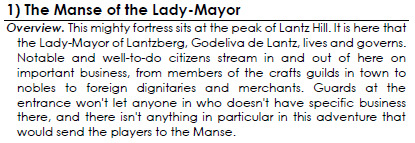
However, and I won't get into too much detail for fear of spoilers, some of those numbers are elaborate, multi-page dungeons.
While you should endeavour to keep the number of districts low, there is no ceiling to how many points of interest you should put into the city. Don't burn yourself out. If you can come up with six, put in six. If you can come up with fifty, put in fifty.
A point of interest can be anything from a scenic overlook to a toll bridge to an elaborate sewer system packed with kobolds and giant rats and treasure. They can be as fleshed out or as minimal as you are comfortable with. There's a sweet spot that varies from GM to GM, as if you include too much detail you suffer from information overload as the party approaches the point of interest (sixteen pages of description, for instance, for a single shop is less than helpful), while too little information might lead to you having to do too much on the fly. I like maybe one to three sentences per point of interest, or per room in a point of interest if it is important enough to warrant its own map (I typically only map dungeons).
Random Encounters
I'll write a series on handling random encounters later, but for now, breaking up encounters by district is a convenient way to do it. More dangerous districts, for instance, might have muggers or even monsters that attack (especially at night). If you're going to use random encounters in your campaign, creating a table for each district lets you use your local colour to affect actual game mechanics. Castleview, for instance, is very safe due to constant patrols by the Lady-Mayor's Watch, while the flooded Lists are full of man-eating fungi, ghouls, criminals, and who knows what. This lets you follow the age-old advice to "show, don't tell." You don't have to say "this area is full of crime," you can show the players this by throwing some criminals at them.
This post has already gone on way longer than intended. Next time, we'll use what we've learned to answer the original question and make better town maps.
18 notes
·
View notes
Photo




Art of Adaptation: The Literary Webseries
Classic novels ingrained in Western culture have been adapted in many ways over years – plays, musicals, miniseries, films, modern teen novels, even text posts (no, really). In recent years, with the success of Game of Thrones, we’re seeing more and more books and series adapted to television format.
But one of my favorite methods of adaptation is one rarely discussed outside of internet culture: the literary web series.
These modern retellings of public domain works turn classic protagonists into Youtube vloggers, who let their story unfold before an audience. Literary web series have to be particularly inventive in bringing classic stories to modern day, organically integrating racial & gender diversity and modern sensibilities to works made over a hundred years ago.
Breaking down the structure of these series, there are five components to an effective adaptation:
Components
Initial conceit (or, why does this character have a blog?)
Audience acknowledgement & interaction
How are other perspectives integrated?
Inventiveness (with camera stuff, settings, etc.)
Quality of Adaptation (modernization of problematic elements, captured the spirit of the original)
Let’s look at some examples to see how this breaks down. (spoilers ahead)
The Lizzie Bennet Diaries, 2012-2013
(Adaptation of Jane Austen’s Pride & Prejudice, 1813)

Conceit
Pretty straightforward – Lizzie Bennet is a grad student in Communications doing this as her project, presenting her views in contrast to her mother’s. What starts out as documenting Lizzie’s opinions ends up getting involved in a whole lot of drama.
Audience acknowledgement & interaction
High acknowledgement and interaction. Lizzie’s videos are very public and very popular in-universe. The story even takes from the audience quite a bit, responding to the multiple requests for Darcy, and even affecting the self-esteem of Lydia. Acknowledges the problems of putting your life and the lives of those around you on the internet, but how communicating with strangers can help to communicate with people closer to you.
Are other perspectives integrated?
Other characters take over Lizzie’s vlog or have their own side vlogs, and show the holes in Lizzie’s sometimes biased logic.
Inventiveness
This was pretty much the first well-known literary web series, so launching the whole art form definitely counts! Also, two words: costume theater.
Quality of Adaptation
Lizzie Bennet Diaries, rather than being a straight point-by-point adaptation, streamlined the events to make sense for modern day – house parties become weddings and pub visits, estates become companies, problems with inheritance laws become problems with student debt and bad economy. Characters barely sketched out in the original text are fleshed out, and Lizzie herself is not only the modern Elizabeth, but the voice of self-exploring 20-somethings everywhere.
But my favorite method of adaptation was the new life injected into main themes of pride and prejudice. When the original book came out, the audience would have been surprised to discover, along with Elizabeth, the hidden depths of Darcy.
200 years later, when “Where is my Darcy?” is the common phrase among Austenites, no one is surprised Darcy is better than he seems. So, Pemberley Digital brought back the element of surprise by making Lydia Bennet, an irresponsible flake in the original book, the one truly misunderstood by Lizzie (though dear Darcy still plays an important role).
The only thing maybe lost in adaptation is the fact that, in the original book, Lizzie was more right than wrong, whereas in the web series, she seems more wrong than right. Additionally, Lizzie’s confrontation with Caroline Lee near the end of the series, meant to mirror the one with Lady Catherine De Bourgh, loses its power since Caroline doesn’t have nearly as much power over Lizzie. Lizzie standing up to her is not as big a deal.
Note: I highly recommend the companion novel The Secret Diary of Lizzie Bennet, as it fills in some elements of the story that couldn’t be put on screen.
Emma Approved, 2013-2014
(Adaptation of Jane Austen’s Emma, 1815)

Conceit
Emma Woodhouse is documenting her greatness in lifestyle excellence as head of the consulting firm Emma Approved. Eh…it does fall in line with the character, but some see it as over-the-top.
Audience acknowledgement & interaction
Emma’s videos, except for the Q&As, are private. But she has cameras on the desks of everyone who works there (to the consternation of some of them). I think this is where a lot of fans got lost, because the audience didn’t affect the story the way it did before.
Harriet’s music videos are a little more interactive, but not part of the main storyline.
Are other perspectives integrated?
Swiveling to other people’s desk cameras helps. Also, Harriet has a music blog which often reflects her mood and her growing confidence in herself.
Inventiveness
Month-long arcs of consulting clients in an office setting. More space, multiple rooms, in-universe charities made real.
Quality of Adaptation
I love the way the characters were adapted, on one hand.The themes of appearance vs. true character are even more apparent in a web series format, where often charisma rules the day. Emma starts out ingratiating, but we really root for her by the end. Knightly is as lovely as ever, but now with more of a sense of humor (also helps that he’s not above Emma in station this time around). Harriet no longer stands in Emma’s shadow and grows beyond a project to a true friend.
The supporting characters are all well-sketched and memorable, with the addition of LBD’s Caroline Lee as the infamous Mrs. Elton an incredible twist. The resolutions of the main pairings (Emma/Knightley and Harriet/B-Mart) were extremely satisfying, almost more so than the ones in LBD!
But the adaptation of the story felt choppy. The month-long arcs of Emma counseling a client weren’t quite organic, and didn’t quite fall in line with the format of the original book. And by keeping the action confined to the offices, it’s argued that an important element of the story – mainly Emma’s interactions with her neighbors and her father – is lost. So, as an adaptation, it may not be the strongest. Still, it’s an enjoyable, inventive twist on a classic.
(Oh, and PS - the actors playing Emma and Knightley ended up dating in real life. If you just watch for their chemistry, that would be enough)
Autobiography of Jane Eyre, 2013-2014
(Adaptation of Charlotte Bronte’s Jane Eyre, 1847)

Conceit
Jane Eyre is a nursing graduate embarking on a new chapter in her life, and wants to be brave like Lizzie. Though Jane narrates her own story in the original book as well, she’s a shy character who might seem unlikely to put herself on display on the internet. But once she gets going it becomes a great form of self-expression for her (the original Jane was an artist, updated to a photographer).
Audience acknowledgement & interaction
Jane’s videos are public, and she does do Q&As, but the audience doesn’t affect the story more than that. However, Jane does acknowledge that her audience might serve as witness to the weirdness going on, proving she isn’t crazy (and possibly account for her whereabouts if she turns up dead! Ah, gothic novels.)
Are other perspectives integrated?
Sometimes other people find the camera, or don’t realize that Jane left her camera on somewhere. Mostly, however, this is Jane’s story, and she tells it well.
Inventiveness
Outdoor shots, not afraid to get downright creepy, meta-commentary episode of Mary Rivers watching all of Jane’s videos.
Quality of Adaptation
Jane Eyre is a pretty weird novel, by modern standards, and a problematic one, what with its shortsighted treatment of race, mental illness (the half-Creole Mason family hinted as being somewhat crude and prone to mental illness), and culture (Adele and her mother are put down for being French), and its arguably unhealthy relationships (since Rochester is kind of a jerk who has slept with a lot of women, and St. John is… well… Jane’s cousin). So I’m glad a lot of this is either removed or approached with more sensitivity, while preserving much of the darkness of the original novel.
However, the adaptation does lose the supernatural element that makes the original a gothic novel. Also, since Jane isn’t facing nearly as steep of odds in terms of her class and gender, she’s as a result a softer character.
But she is nonetheless strong and principled in the face of going it alone, and her story of finding a place and people to belong to is just as fulfilling as the original.Though the ending may feel rushed due to circumstances beyond the show’s control, overall it’s a strong modern adaptation.
The New Adventures of Peter and Wendy, 2014-2016
(Adaptation of J.M. Barrie’s 1904 play, Peter Pan, and 1911 novel, Peter and Wendy)
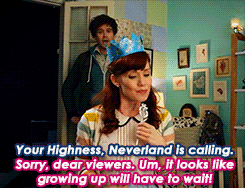
Note: This only covers Seasons 1-2, as I haven’t gotten around to Season 3 yet.
Conceit
In the town of Neverland, Ohio, 27-year-old Wendy Darling runs an advice blog through her family’s paper, the Kensington Chronicle, which also captures the lives of her brothers, John and Michael, her vitriolic female friend Lily Bagha, and her best friend (who wants the be more-than-a-friend), Peter Pan.
The blog fits with Wendy’s motherly personality from the original story, but realistically doesn’t show all the action happening in front of Wendy’s camera.Not-as-realistically, the rest of the action occurs from Tinkerbell’s perspective, but it is so brilliantly done that it seems like fairies should have been included in a web series ages ago!
Audience acknowledgement & interaction
On Wendy’s vlogs, Wendy does talk to the audience and answers questions, though I think most are fabricated to move the plot along.During the fairy-cam moments, no acknowledgement of audience directly, but the businesses and characters created by audience members on the Neverland Twitter registrar are sometimes referenced (and on that note, the P + W social media platforms interact a LOT with their audience).
Are other perspectives integrated?
The fairy-cam gives the audience more movement and perspectives than Wendy’s vlog alone would allow, and each character gets their day in the sun, so kudos to P + W for that! Season 2 also adds cameras in Wendy’s office at JhMedia (similar to Emma Approved) and Peter’s playacting videos, splitting the narrative between the small town and the big city in interesting parallel ways.
Inventiveness
The fairy-cam, and inclusion of magic in a web series in general (though it doesn’t really effect the plot). Also, surprisingly might be the most lewd of the shows reviewed so far, due to veiled references to smoking pot and “magic” brownies.
Quality of Adaptation
New Peter + Wendy is by no means a faithful adaptation of the beloved novel in terms of plot. And really, how could it be? By choosing a fantasy over a comedy of manners/period piece, the creators faced a particularly huge challenge in adaptation.
The basic tenants are there – Wendy being too old to stay where she is, escapes with Peter, but realizes she has to grow up and leave Neverland, leaving Peter behind by his own choice. But other than that, the adaptation basically takes the original characters, fleshes them out as modern 20-year-olds, and uses them and Neverland as a launch point for a rumination of what it means to grow up – or not – in the 2010s. This is highlighted even more by depicting the Neverland gang and the pirates/executives of JHMedia as contemporaries. Adulthood, here, is not about age but about attitude.
The characterizations are spot on, the plot both whimsical and deeply thought provoking, and the magic of the original is still retained in surprising ways. They even made sure Hook went by “Jas” rather than “James,” a facet of the original story lost in time.
Changing Tiger Lily, a stereotyped Native American character, into a complex woman of actual Indian descent, sacrifices the problematic element of the character without whitewashing, which the reviled prequel Pan got flack for. In a major departure, the web series also explores sexuality more in depth. (If you’d told me John Darling and Smee could be an adorable pairing before this series, I’d have called you crazy. But there you go.)
Wendy’s character, however, strays from the original in that she is allowed to be more flawed. The original Wendy was meant to be an argument in favor of women’s suffrage by depicting a female character as more sensible and responsible than the male characters. While modern Wendy is still the most responsible of her friends, she is also zany, ambitious, and sometimes even cruel, making some questionable decisions the original Wendy might not have made. Her character arc reminds me a bit of Peter Banning’s in Hook as she tries to find balance between childhood and adulthood.
I can’t say whether it was effective or not without seeing Season 3, but I love that the writers are tackling those themes.
It’s difficult to pinpoint a single element that makes an adaptation a good one. But if I had to take a stab, I think it is heart, humor, and sincerity in the characters, plus a relatable plot dealing with changes and new beginnings, that most draws people to a series, and all the ones above definitely managed to capture that!
For more literary web series, check out this comprehensive list. My recommendations: Misselthwaite Archives, From Mansfield with Love, Northbound, The Cate Morland Chronicles, Edgar Allen Poe’s Murder Mystery Dinner Party/Gala for Friends Potluck (aka Poe Party).
So, what do you think? Do you think these web series capture the best of the books they’re based on? Got any other examples you want to talk about?
#literary web series#lizzie bennet diaries#emma approved#autobiography of jane eyre#aoje#lbd#the lbd#new peter and wendy#new adventures of peter and wendy
22 notes
·
View notes